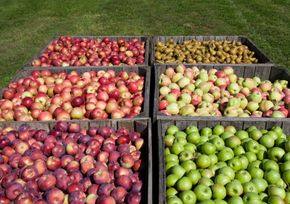 “A medium-sized apple contains about 72 calories. See more apple pictures.©iStockphoto.com/Michael Krinke
“A medium-sized apple contains about 72 calories. See more apple pictures.©iStockphoto.com/Michael Krinke
Despite what you hear from the purveyors of trendy fad diets, specialty diet foods, and expensive weight-loss programs, there is no secret to dropping pounds. You simply need to use more calories than you consume.
To put things into perspective, here are the calorie counts for some typical foods — keep in mind that the exact number of calories can vary.
Food: Calories
1. Apple, medium: 72
2. Bagel: 289
3. Banana, medium: 105
4. Beer (regular, 12 ounces): 153
5. Bread (one slice, wheat or white): 66
6. Butter (salted, 1 tablespoon): 102
7. Carrots (raw, 1 cup): 52
8. Cheddar cheese (1 slice): 113
9. Chicken breast (boneless, skinless, roasted, 3 ounces): 142
10. Chili with beans (canned, 1 cup): 287
11. Chocolate chip cookie (from packaged dough): 59
12. Coffee (regular, brewed from grounds, black): 2
13. Cola (12 ounces): 136
14. Corn (canned, sweet yellow whole kernel, drained, 1 cup): 180
15. Egg (large, scrambled): 102
16. Graham cracker (plain, honey, or cinnamon): 59
17. Granola bar (chewy, with raisins, 1.5-ounce bar): 193
18. Green beans (canned, drained, 1 cup): 40
19. Ground beef patty 193 (15 percent fat, 4 ounces, pan-broiled):
20. Hot dog (beef and pork): 137
21. Ice cream (vanilla, 4 ounces): 145
22. Jelly doughnut: 289
23. Ketchup (1 tablespoon): 15
24. Milk (2 percent milk fat, 8 ounces): 122
25. Mixed nuts (dry roasted, with peanuts, salted, 1 ounce): 168
26. Mustard, yellow (2 teaspoons): 6
27. Oatmeal (plain, cooked in water without salt, 1 cup): 147
28. Orange juice (frozen concentrate, made with water, 8 ounces): 112
29. Peanut butter (creamy, 2 tablespoons): 180
30. Pizza (pepperoni, regular crust, one slice): 298
31. Pork chop (center rib, boneless, broiled, 3 ounces): 221
32. Potato, medium (baked, including skin): 161
33. Potato chips (plain, salted, 1 ounce): 155
34. Pretzels (hard, plain, salted, 1 ounce): 108
35. Raisins (1.5 ounces): 130
36. Ranch salad dressing (2 tablespoons): 146
37. Red wine (cabernet sauvignon, 5 ounces): 123
38. Rice (white, long grain, cooked, 1 cup): 205
39. Salsa (4 ounces): 35
40. Shrimp (cooked under moist heat, 3 ounces): 84
41. Spaghetti (cooked, enriched, without added salt, 1 cup): 221
42. Spaghetti sauce (marinara, ready to serve, 4 ounces): 92
43. Tuna (light, canned in water, drained, 3 ounces): 100
44. White wine (sauvignon blanc, 5 ounces): 121
45. Yellow cake with chocolate frosting (one piece): 243
Source: USDA National Nutrient Database for Standard Reference, Release 19 (2006)
CONTRIBUTING WRITERS:
Helen Davies, Marjorie Dorfman, Mary Fons, Deborah Hawkins, Martin Hintz, Linnea Lundgren, David Priess, Julia Clark Robinson, Paul Seaburn, Heidi Stevens, and Steve Theunissen
Originally Published: Sep 13, 2007
Calories in Food FAQ
How many food calories should I eat a day?
Your required calorie intake depends on many different factors like your sex, weight, age, size, height, activity level and overall health. However, the Dietary Guidelines for Americans suggests that men should take in 2000 to 3000 calories per day, while women need 1600 to 2400 calories every day.
How many calories should I eat in a day to lose weight?
Generally, if you’re on a weight-loss diet, you should consume 500 fewer calories than what you need to maintain your present weight. Following this routine is said to reduce about 1 pound of your body weight every week. But you should speak with your doctor or nutritionist to determine the best course of action, as counting and limiting calories can trigger disordered eating.
What foods to avoid to maintain a good calorie level?
You don’t need to completely eliminate any foods to lose weight. However, limiting the amount of sugary and processed foods is good for your health and can help you lose weight.
Lots More Information
Related Articles
- How Calories Work
- How Food Works
- How Fat Works
- How Fat Cells Work
- How Dieting Works
- How Cholesterol Works
- How Exercise Works
- Does drinking ice water burn calories?
- How many calories does a person need daily?







































